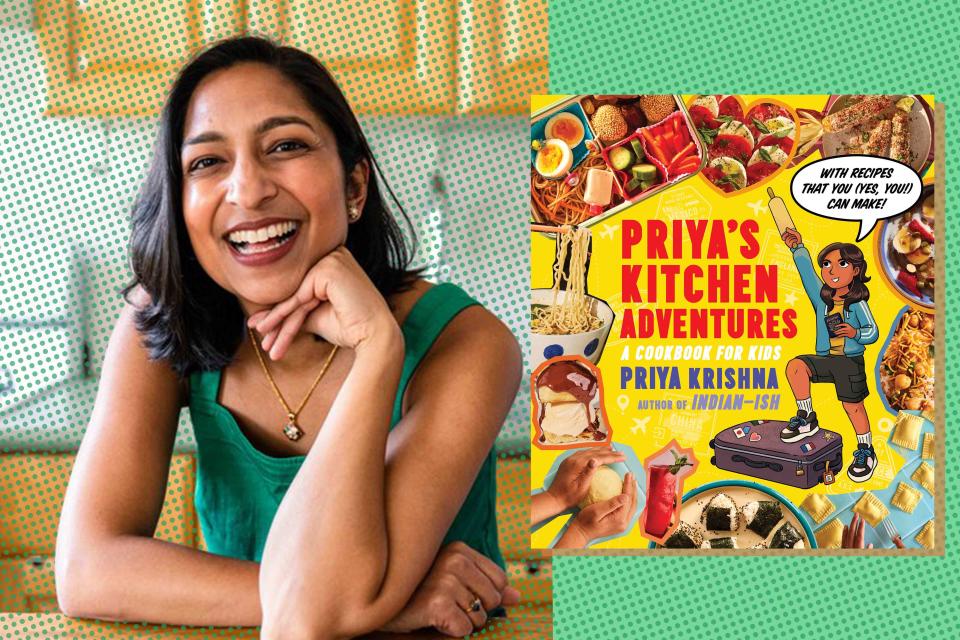Want Your Kid To Become an Adult That Cooks? Get This Cookbook
Priya Krishna’s book “Priya’s Kitchen Adventures” is the cookbook the author wishes she had as a child.

Simply Recipes / Photo Illustration by Wanda Abraham / Marc Franklin
Welcome to One Quick Bite, where we share smart, cool, and weird conversations with our favorite authors about their new cookbook and beyond.
Priya Krishna, acclaimed author of Indian-ish and reporter for The New York Times, didn’t come up with the idea to write a cookbook for children. Her publisher approached her with the proposal, which led to her latest cookbook, Priya’s Kitchen Adventures. “My publisher said, ‘You have a really youthful voice. Would you consider writing a cookbook for kids?’...I guess I’ll take that as a compliment,” Krishna, who is child-free, shares with me over Zoom.
Krishna talked it over with her mother who reminded her that she had loved cooking and cookbooks as a child. She fondly remembers the first dish she made for herself: Green Spaghetti, which was just spaghetti with pesto. “I oversalted the first batch I made, but the green color mesmerized me and I’ve loved pesto ever since,” she shares.
However, when Krishna thinks back to the books she’d flipped through as a budding cook, she remembers them as heavily focused on Euro-centric foods. Most of the dishes didn’t look anything like the foods she, the child of Indian immigrants, grew up eating. “So many [of the books] didn’t feel like they were for me,” she says.
They were also chock full of simplistic recipes that “spoke down to kids rather than empowering them,” remarks Krishna. The more she considered her publisher’s proposal, the more she realized that there was room for a cookbook “that empowered kids and felt inclusive, to help children from all backgrounds feel seen.”
You only have to casually flip through Priya’s Kitchen Adventures to clock the difference between her book and other cookbooks for children on the market. An ode to the travels she took with her family as a kid, the book is organized by country, from Greece to Trinidad and Tobago, rather than the standard breakfast, lunch, and dinner spread.
The recipes aren’t cutesy, either. Many mirror recipes an adult might make, including elotes, quiche Lorraine, and vegetable tagine. “The more I developed recipes for the book, the more I realized that the line between recipes for adults and kids is a lot blurrier than we think,” says Krishna.
There are certainly some concessions made for young cooks. The recipes in Priya’s Kitchen Adventures involve minimal chopping and no special equipment like stand mixers or mandoline slicers. Icons indicate when a step might require an adult’s help, like chopping vegetables or cooking on the stovetop. Krishna “want[s] kids to be able to do a lot of the cooking on their own,” without the constant assistance of an adult.
The instructions in Krishna’s recipes are clear and straightforward, without the specialized recipe jargon that can trip up even experienced adult cooks. Bright, colorful photos accompany most of the recipes. For more complex projects, like Pear and Gorgonzola Ravioli, step-by-step photos supplement the instructions.
Krishna’s recipes encourage experimentation, empowering kids to learn to cook, rather than just following a recipe. “I give lots of options for toppings and garnishes to empower kids to adapt dishes to their tastes,” says Krishna. In the Pozole Verde con Pollo recipe, that means a trove of optional toppings like sliced avocado, crumbled queso fresco, and sliced radishes. Krishna’s Koshari recipe includes an optional spicy sauce called daqqa.
And this is where Priya’s Kitchen Adventures is perhaps most surprising. Children are thought to have picky, unadventurous tastes. Recipes for children are often mild and lean heavily on lowest common denominator foods like pasta, but Krishna’s book trusts children to branch out and embrace complexity.
However, this book isn’t just an adult’s idea of what children should cook and eat. All the recipes were tested by children ages three to 13. Krishna was “surprised by how much about flavor the kids picked up on. They were figuring out how flavor works in real-time.”
She reveals that the most surprising thing about working with kids as recipe testers was “How good they were! They were better than my Indian-ish testers!”
Adult testers can err towards being polite, masking harsher criticisms to spare the recipe developer’s feelings. “Kids don’t care about that—they’re direct. So I knew that when they said they liked something, they really meant it.”
Even though I am a fully-fledged adult, as I flipped through Krishna’s cookbook I found myself flagging recipe after recipe and thinking about my childhood food dreams. The spanakopita recipe in particular stopped me in my tracks—sautéed spinach was one of my favorite foods as a kid.
To have an adult tell me I was capable of making the flaky spinach and feta-stuffed Greek pastry would have made my year. Turns out, most of us, kids included, get a lot of mileage out of a little confidence boost in the kitchen.
BUY THE COOKBOOK: Priya’s Kitchen Adventures
Read the original article on Simply Recipes.

